Have you ever wondered how many calories you’re burning while exercising? One way exercise experts estimate calories burned during activity is by using the metabolic equivalent of the task, also called the MET value.1 The MET value represents the energy required for that activity.
Calories and METs
To understand MET values, it’s helpful to know a bit about calories. A calorie is a unit of energy. You need energy from calories for your body to function properly. To maintain your current weight, the number of calories your body uses should be the same as the number of calories you eat and drink.2 To lose weight, you need to expend more calories than you take in.
METs are a value indicating the rate at which you burn calories (kcals) during an activity. METs are measured by how much oxygen the body uses during an activity (called your volume of oxygen consumption or VO2) compared to how much oxygen the body uses at rest (called your resting metabolic rate or RMR).1,3
One MET is defined as the energy cost (or caloric consumption) of a person at rest (sitting quietly).3,4 So, if a person does a 2.0 MET activity, they expend twice the energy used by the body at rest; if they do a 3.0 MET activity, they expend 3 times the energy used by the body at rest, and so on.
MET Values for Your Activities
The Compendium of Physical Activities was developed as a standardized tool to express the MET values of a wide variety of physical activities.3 To find the MET values of your preferred activities, you can refer to the activity categories in the Compendium.3 The MET values in the Compendium range from 0.9 METs for sleeping to 23 METs for running at 14 miles per hour (mph).3 The Compendium contains both traditional physical activities like bicycling, swimming, and sports, but also gardening and lawn care, home repair, and a myriad of other activities – even brushing your teeth!
MET values can be translated into light, moderate, and vigorous intensities of physical activity:
- Light-intensity activities are defined as non-sedentary behaviors of less than 3.0 METs. Walking at a pace of 2.0 mph requires 2.5 METs of energy expenditure and is therefore considered a light-intensity activity.
- Moderate-intensity activities are defined as 3.0 to 5.9 METs. Walking at a pace of 3.0 mph requires 3.5 METs of energy expenditure and is therefore considered a moderate-intensity activity.
- Vigorous-intensity activities are defined as 6.0 METs or more. Running a mile at a pace of 6.0 mph is a 10 MET activity and is therefore classified as a vigorous-intensity activity.6
So, to follow the Physical Activity Guidelines for Americans,6 which recommends 150 minutes of moderate-intensity or 75 minutes of vigorous-intensity activity per week~
- Moderate-intensity activities are those that cause you to move fast enough or strenuously enough to burn roughly 3.0 – 5.9 times as much energy per minute as you do when you’re sitting quietly. Thus, moderate intensity activities are those that require 3.0 – 5.9 METS, like walking at 3-4 mph.7
- Vigorous-intensity activities are those that cause you to move fast enough or strenuously enough to burn at least 6.0 times as much energy per minute as you do when you’re sitting quietly. Thus, vigorous-intensity activities are those that require 6.0 or more METs, like running a 15-min (or faster) mile.3
Calculating Calories Burned
One MET is the energy cost of a person at rest,3 and is equal to about 1 calorie burned per kilogram of body weight per hour (1 kcal/kg/hour),7 or about 1 calorie burned for every 2.2 pounds of body weight per hour, for the average adult.8 (To convert your weight from pounds to kilograms, simply divide the number in pounds by 2.2.)
With this information, you can estimate calories burned during physical activity with the following equation:9

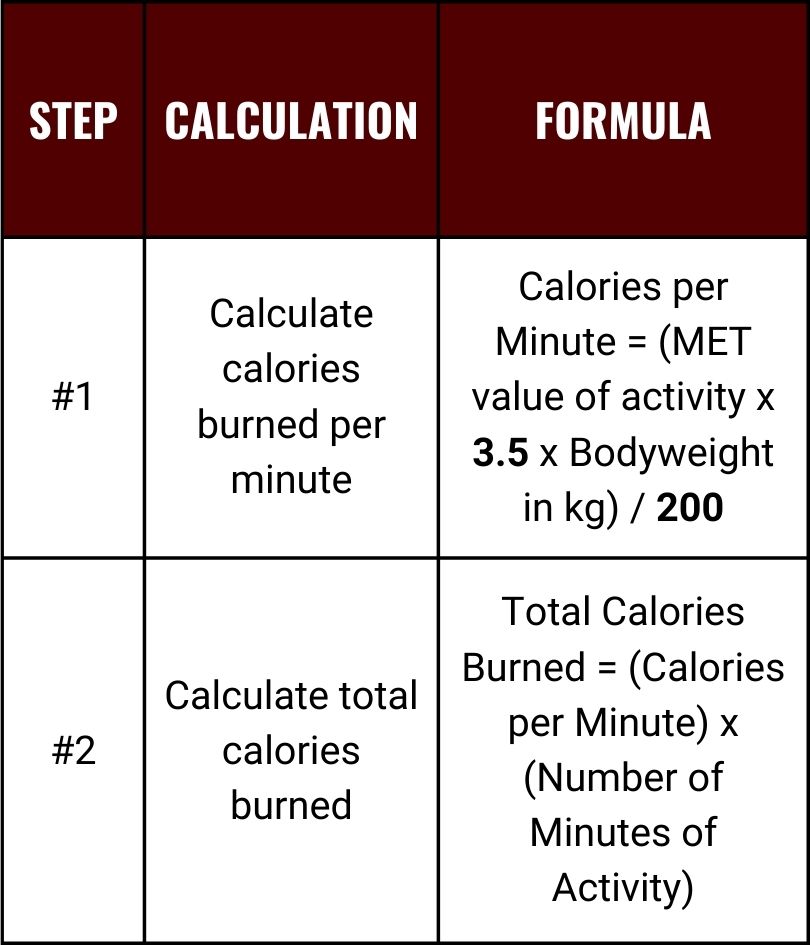
The bold numbers in the equation stay constant. Look up MET values for activities and use Google to convert pounds (lbs) into kilograms (kg).
Example 1
For example, an individual who weighs 165 pounds (75 kg) and walks at a 3.0 mph pace for 45 minutes would burn an estimated 207 calories.
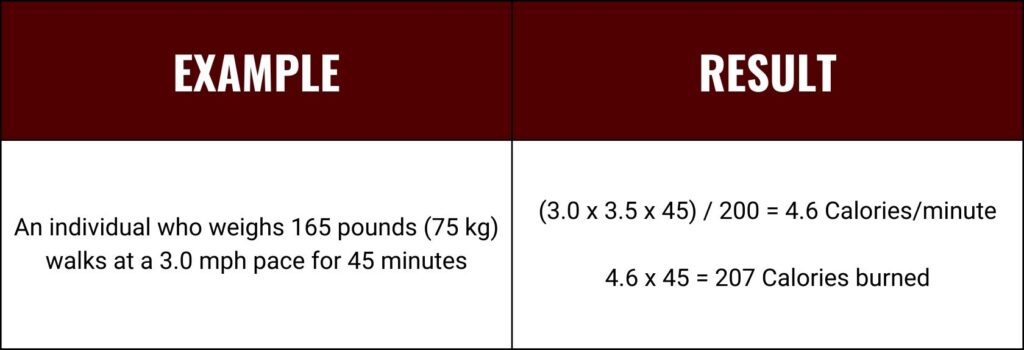
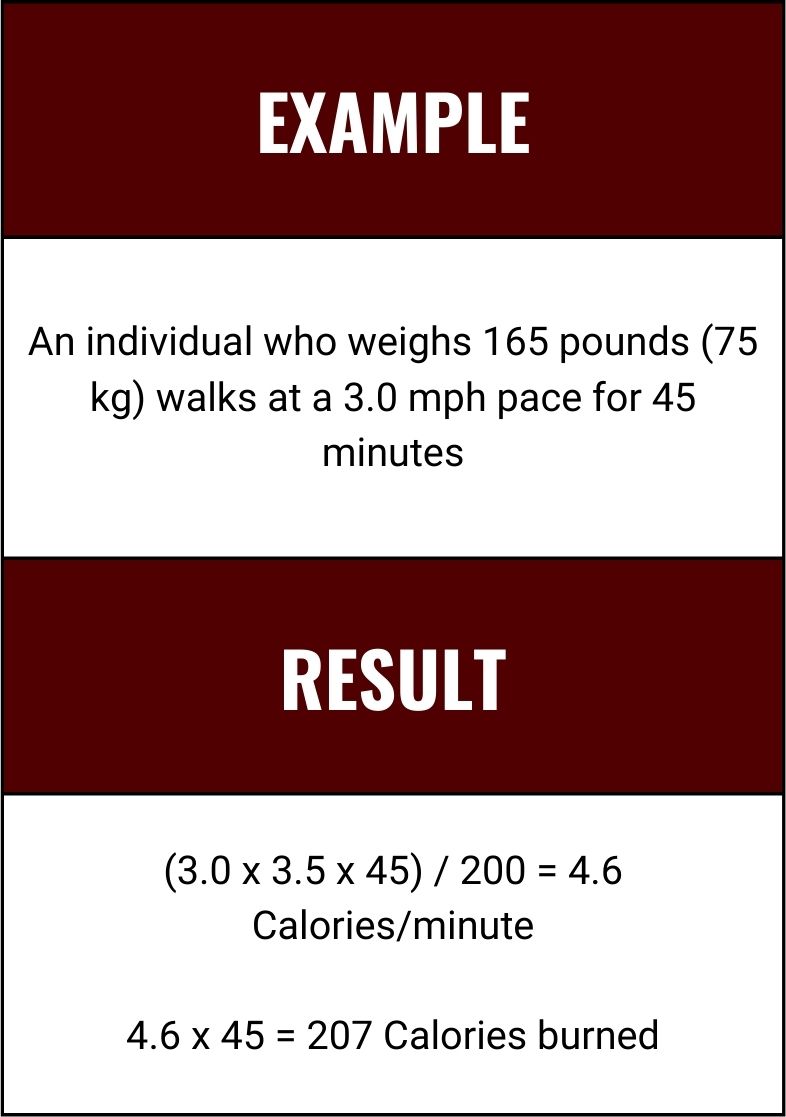
Example 2
As another example, an individual who weighs 180 pounds (82 kg) and mows the lawn (5.5 METs) for 1 hour would burn an estimated 474 calories. (Note: In this example, be sure to convert hours to minutes.)
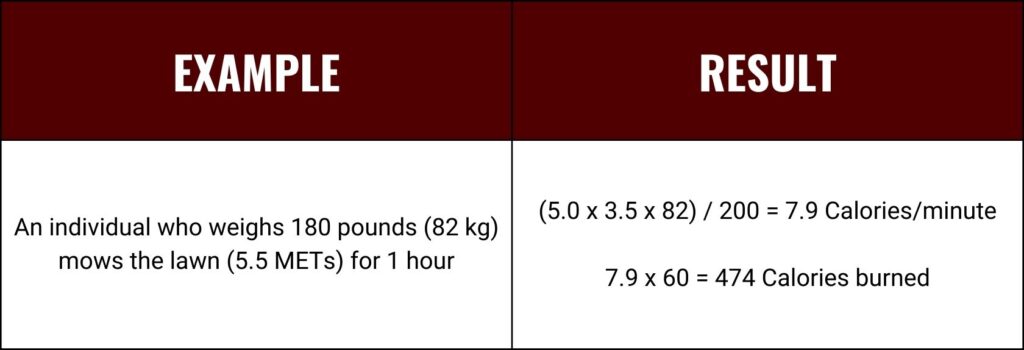
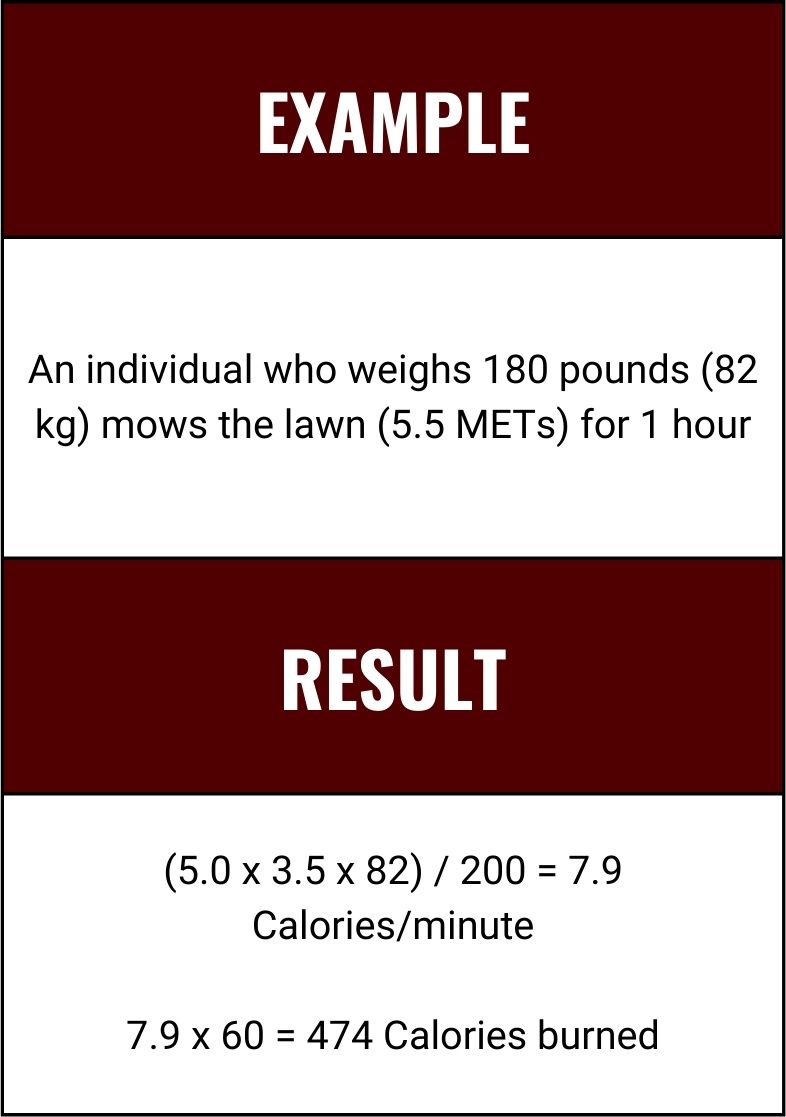
Keep in Mind
MET values are just an estimate of the energy you use. MET values apply to the average individual, but don’t take differences into account.7 MET values have limitations that include fitness level, age, gender, body fat, muscle mass, and level of health.1 For example, walking a 3.0 mph mile would likely be an easy activity for a young marathon runner, while it would likely be a very hard activity for an inactive 90-year-old.1 So, these calculations are only estimates of calories expended. True calorie expenditure varies from person to person. Still, these calculations can help you estimate the number of calories you burn during your choice of exercise and move you toward your fitness and weight loss goals.
Need some extra motivation to meet your fitness goals?
- Kaminski J. Metabolic equivalents: What are they & how to calculate them. NASM. Accessed September 8, 2023. https://blog.nasm.org/metabolic-equivalents-for-weight-loss.
- National Health Service. Understanding calories. NHS choices. April 17, 2023. Accessed September 8, 2023. https://www.nhs.uk/live-well/healthy-weight/managing-your-weight/understanding-calories/.
- Ainsworth BE, Haskell WL, Herrmann SD, Meckes N, Bassett DR Jr, Tudor-Locke C, Greer JL, Vezina J, Whitt-Glover MC, Leon AS. 2011 Compendium of Physical Activities: a second update of codes and MET values. Med Sci Sports Exerc. 2011 Aug;43(8):1575-81. doi: 10.1249/MSS.0b013e31821ece12.
- Jetté M, Sidney K, Blümchen G. Metabolic equivalents (METS) in exercise testing, exercise prescription, and evaluation of functional capacity. Clin Cardiol. 1990 Aug;13(8):555-65. doi: 10.1002/clc.4960130809. PMID: 2204507.
- Kumar, K. Kcal vs. Calories: Differences and How to Convert. Medicinenet. July 7, 2022. Accessed September 8, 2023. https://www.medicinenet.com/kcal_vs_calories_differences_and_how_to_convert/article.htm.
- U.S. Department of Health and Human Services (2018). Physical activity guidelines for Americans, 2nd edition. Washington, DC: U.S. Department of Health and Human Services. https://health.gov/sites/default/files/2019-09/Physical_Activity_Guidelines_2nd_edition.pdf
- Mark, Naylor V, Silverstein HR, et al. The Compendium of Physical Activities: Mets for all. The Skeptical Cardiologist. January 17, 2021. Accessed September 8, 2023. https://theskepticalcardiologist.com/2021/01/17/the-compendium-of-physical-activities-mets-for-all/.
- Staying active. The Nutrition Source. February 2, 2023. Accessed September 8, 2023. https://www.hsph.harvard.edu/nutritionsource/staying-active/.
- Bushman, B. Complete Guide to Fitness and Health 2nd Edition. American College of Sports Medicine, Human Kinetics, 2017.







